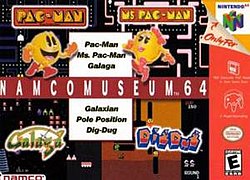Namco Museum Volume 1
| Namco Museum | |
|---|---|
| Genres | Compilation |
| Developers | Namco |
| Publishers | Bandai Namco |
| Platforms | PlayStation, Dreamcast, Game Boy Advance, Nintendo 64, PlayStation 2, Xbox, GameCube, Microsoft Windows, Nintendo DS, Xbox 360, PlayStation 3, Xbox Live, PlayStation Network, Virtual Console, Nintendo Switch |
| Platform of origin | PlayStation |
| First release |
Namco Museum Volume 1 November 22, 1995 |
| Latest release |
Namco Museum (Nintendo Switch) July 28, 2017 |
| Namco Museum Volume 1 | |
|---|---|
 |
|
| Developer(s) | Now Production |
| Publisher(s) |
Namco |
| Platform(s) | PlayStation |
| Release | |
| Genre(s) | Compilation |
| Mode(s) | Single player, multi player |
| Namco Museum Volume 2 | |
|---|---|
 |
|
| Developer(s) | Namco |
| Publisher(s) | Namco SCEE |
| Platform(s) | PlayStation |
| Release | |
| Genre(s) | Compilation |
| Mode(s) | Single player, multi player |
| Namco Museum Volume 3 | |
|---|---|
| Developer(s) | Now Production |
| Publisher(s) |
Namco SCEE |
| Platform(s) | PlayStation |
| Release | |
| Genre(s) | Compilation |
| Mode(s) | Single player, multi player |
| Namco Museum Volume 4 | |
|---|---|
| Developer(s) | Namco |
| Publisher(s) | Namco SCEE |
| Platform(s) | PlayStation |
| Release | |
| Genre(s) | Compilation |
| Mode(s) | Single player, multi player |
| Namco Museum Volume 5 | |
|---|---|
| Developer(s) | Tose |
| Publisher(s) | Namco SCEE |
| Platform(s) | PlayStation |
| Release | |
| Genre(s) | Compilation |
| Mode(s) | Single player, multi player |
| Namco Museum Encore | |
|---|---|
| Developer(s) | Namco |
| Publisher(s) | Namco |
| Platform(s) | PlayStation |
| Release |
|
| Genre(s) | Compilation |
| Mode(s) | Single player, multi player |
| Namco Museum Namco Museum 64 |
|
|---|---|

North American Nintendo 64 cover art
|
|
| Developer(s) | Mass Media |
| Publisher(s) | Namco |
| Platform(s) | Dreamcast, Game Boy Advance, Nintendo 64, Wii U Virtual Console (GBA version) |
| Release |
Nintendo 64
|
| Genre(s) | Compilation |
| Mode(s) | Single player |
| Namco Museum: 50th Anniversary | |
|---|---|
| Developer(s) | Digital Eclipse |
| Publisher(s) | Namco |
| Platform(s) | PlayStation 2 Xbox GameCube PC Game Boy Advance |
| Release |
|
| Genre(s) | Compilation |
| Mode(s) | Single player, multi player |
| Namco Museum DS | |
|---|---|
 |
|
| Developer(s) | M2 |
| Publisher(s) |
Namco (Japan and Europe) Namco Bandai Games (North America) |
| Composer(s) | Manabu Namiki |
| Platform(s) | Nintendo DS |
| Release | |
| Genre(s) | Compilation |
| Mode(s) | Single Player, Multiplayer |
Namco Museum (ナムコミュージアム Namuko Myūjiamu) refers to the series of video game compilations released by Namco for various consoles released in the 5th generation and above, containing releases primarily from their arcade games from the 1980s and early 1990s. Namco started releasing compilations with the Namco Museum title in 1995 and continues as of 2017.
The series began on the PlayStation with the tentatively named Namco Museum Volume 1, indicating Namco's intent to make further installments of the series. The series ran until Volume 5 on the PlayStation, covering various games from the late 1980s, before moving onto the Nintendo 64, all of the major sixth generation and seventh generation consoles, Windows PC, and Nintendo Switch.
There are six different volumes available for the PlayStation, including one (Namco Museum Encore) that was released only in Japan. Each volume has five to seven games; all of these were ported from the original arcade version's source code — some of the games such as Galaga and Pac-Man allowed for an alternative screen mode to compensate for the lack of vertical monitor, whereby the scoreboard was located on the left of the screen, or rotated the image 90 degrees if the user possessed a vertical monitor or was willing to risk placing the television/monitor on its side.
The control systems of each of the games were well preserved. However, since the PlayStation's analog controller was not available at the time, analog control for Pole Position and Pole Position II is only supported in this compilation by Namco's neGcon joypad.
...
Wikipedia
